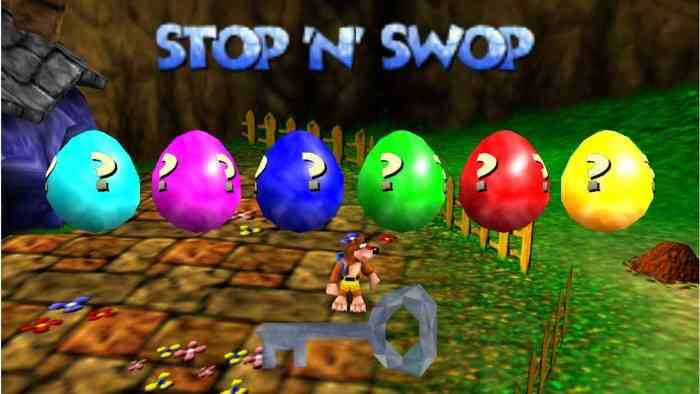The ACM (Advanced Computer Modelling) graphics engine for Donkey Kong Country was the cream of the graphics crop, near the end of the Super Nintendo’s lifespan. When Nintendo announced the N64, Rare shifted the development of Project Dream to it, hoping the new system power would allow them to build their grand schemes.
At some point in development, Rare fell out of love with Edison’s design (they found it to be too generic), so they turned him into a rabbit. But because a rabbit running on two legs was too weird, they turned that rabbit into a bear, with a backpack full of stuff. After adding power ups that created wings for double jumping, and a second pair of fast-moving legs, the developers decided to just stick a bird in the backpack, and the main characters were born!
Kazooie was originally named Kazoo, after the heavenly instrument the game’s developers, for some reason, found annoying. This inspired them to create Kazooie’s annoying sounding voice, and penchant for sarcastically mocking everyone and everything. Because voice acting was still in its infancy in 1998 (see Resident Evil for proof), Rare decided to give Banjo-Kazooie’s characters noises that represented their personalities (Boggy the bear being my favorite).
There were a lot of unused ideas for Banjo-Kazooie, which have now become highly sought after on the internet. There is a moment at the end of the game SPOILERS: where it was intended that Gruntilda’s final fireball, which she threw before dying, would hit Banjo, and turn him into a frog. The idea was that his sister Tooty would have an epilogue-like quest to turn him back, or perhaps a sequel game. END SPOILERS. There was also an intended multiplayer component to the game that got scrapped.
There is evidence of abandoned levels, including Fungus Forest (which was eventually used in Donkey Kong 64), Mount Fire Eyes (which likely became Hailfire Peaks in Banjo-Tooie), and the Giant’s Lair (which was beta testing level abandoned early on). The reason these levels have become so legendary, is that there are hints to them found within the game. There is a photo of Fungus Forest on the wall of Banjo’s house. One of the game’s characters, Gobi, says he’s leaving and “going to the Lava World”… Banjo-Kazooie had no “Lava World.” This, and the gigantic, unreachable ice key in Freezeezy Peak, were two very large mysteries to young me.
That key was connected to an unused feature called Stop ‘N’ Swop, where players had to collect hidden items in the game, after entering a password from Banjo-Tooie. The feature was cancelled, because, originally, to use this feature, players had a 10 second window to swap game cartridges, but models of the N64 made after 1999 made it so the window could only be 1 second, and there was a much greater risk of players damaging their software.
An anonymous ex-Rare employee described Stop ‘N’ Swap as working like this: “Only four eggs and the ice key were involved. Two eggs (the cyan and yellow eggs, found in Mad Monster Mansion and Click Clock Wood) were ‘bad eggs’ that would not be pointed to by Tooie, and would prevent Stop ‘N’ Swop from working since only hackers would have access to them. Blackeye the pirate would give out sandcastle codes in Tooie in return for completing tasks, allowing the collection of the “good eggs” and ice key in Banjo-Kazooie. By going through the gold warp pot in the Grunty’s Furnace Fun with the appropriate items, the ice key would sparkle and open one of the locked doors in the transformation room seen in the game over sequence (owing to a programming mistake, the ice key would disappear afterward, so this would only work once). Going through this door would result in Grunty complaining about Blackeye, and a message to swap cartridges. In Tooie, the four eggs would be used to enable special transformations: Kazooie to a dragon (the only one remaining in the final game), Banjo to a polar bear, and two unspecified transformations that were never coded owing to the abandonment of the feature, as ‘fun and useful, but not needed’ bonuses for those who had both games.”
There are several references to Stop ‘N’ Swop peppered throughout Rare’s post-Banjo-Tooie games. And the Xbox 360 versions have built in Stop ‘N’ Swop functionality with Banjo-Kazooie: Nuts & Bolts.
These articles will be released every month on COGconnected, and split up into 4 weekly parts: The Intro, The History, The Review, and The Verdict. So here ends The History. Next week: The Review!

